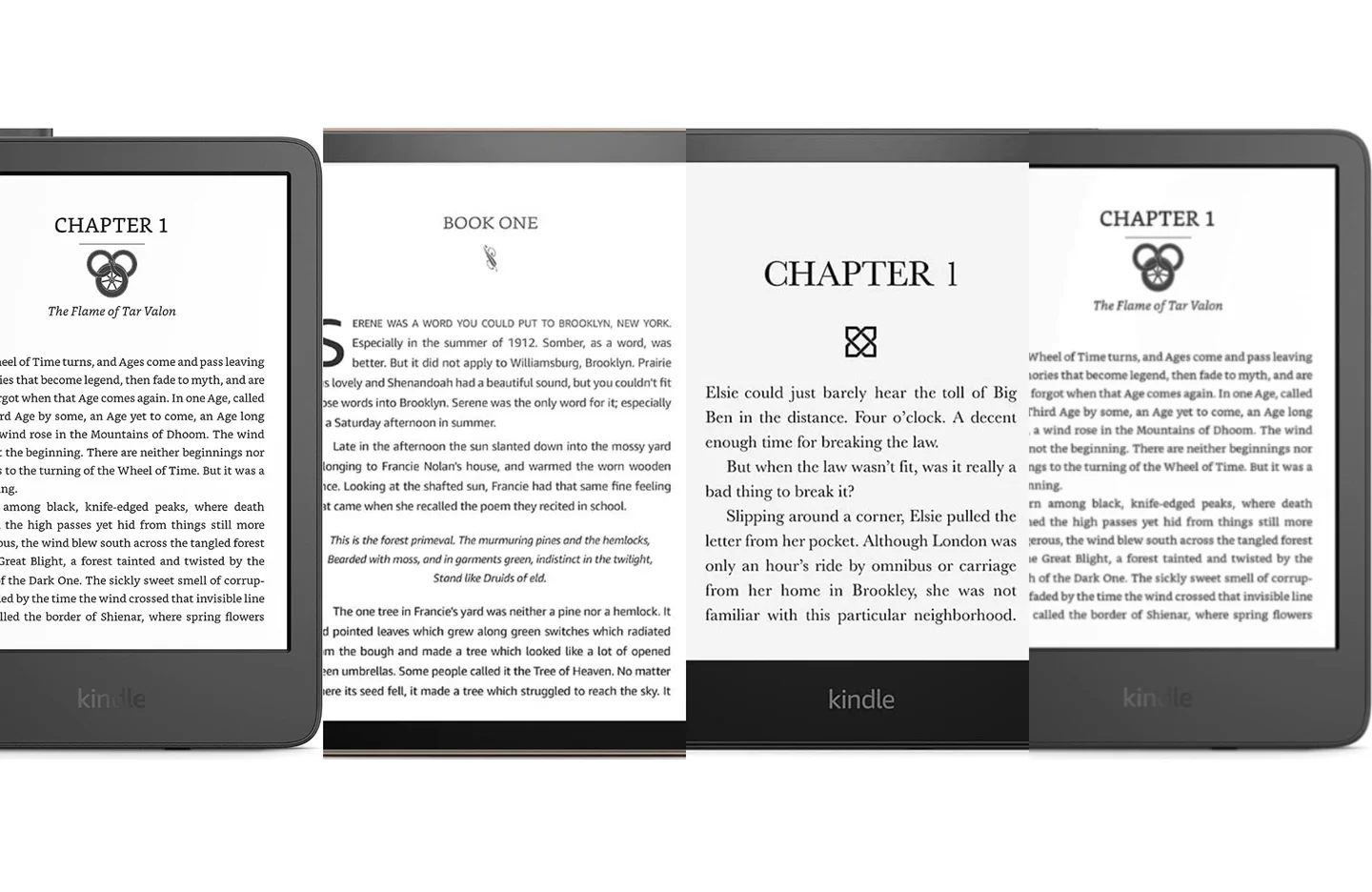Introduction
Welcome to our guide on how to format an eBook for Kindle. In this digital age, self-publishing has become a popular choice for authors, and Kindle Direct Publishing (KDP) offers a convenient platform for reaching a wide audience. However, to ensure your eBook looks professional and is easy to read, proper formatting is crucial.
Formatting an eBook may seem intimidating, especially if you’re new to self-publishing or not familiar with HTML. Thankfully, Kindle offers a simplified formatting process that allows you to create a polished eBook without any coding knowledge.
In this article, we will take you through the step-by-step process of formatting an eBook for Kindle. Whether you’re preparing a manuscript from scratch or converting an existing document into an eBook format, we’ve got you covered.
Before we dive into the specifics, it’s important to note that Kindle supports various file formats, including MOBI, EPUB, and HTML. However, for the purpose of this guide, we will focus on formatting using HTML as it provides more flexibility and control over the final appearance of your eBook.
Now, let’s get started with the first step: preparing your manuscript. It’s crucial to ensure your manuscript is clean and free from any formatting issues before proceeding with the eBook formatting process.
Step 1: Prepare Your Manuscript
Before diving into eBook formatting, it’s essential to prepare your manuscript properly. This step is crucial as it sets the foundation for an error-free and professionally formatted eBook. Here are a few key things to keep in mind:
1. Proofread and Edit: Go through your manuscript with a fine-toothed comb, checking for any typos, grammatical errors, or formatting inconsistencies. Ensure that your writing is clear, concise, and engaging. Remember, a well-edited manuscript forms the basis of a polished eBook.
2. Remove Special Formatting: If your manuscript contains special formatting, such as headers, footers, or page numbers, remove them as they may not translate well into eBook format. Simplifying the formatting helps create a seamless reading experience on Kindle devices.
3. Organize Chapters and Sections: Organize your content into logical chapters and sections. This will make navigation easier for readers and allow you to create an accurate table of contents (which we’ll cover later). Each chapter should begin on a new page for clarity.
4. Use Standard Fonts and Sizes: Stick to standard fonts like Arial, Times New Roman, or Calibri to ensure compatibility across Kindle devices. Select a font size that is comfortable to read—usually between 10 and 12 points.
5. Convert to a Clean Text File: Save your manuscript as a plain text (.txt) file to remove any hidden or unwanted formatting. This step will provide a clean and ready-to-format document for the eBook conversion process.
By following these steps, you’ll ensure your manuscript is in excellent shape and ready for the eBook formatting process. Once you have a pristine manuscript, you’re ready to move on to the next step: choosing the right file format.
Step 2: Choose the Right File Format
When it comes to formatting an eBook for Kindle, choosing the right file format is essential. Kindle supports several formats, but for this guide, we will focus on HTML. Here’s why:
1. Flexibility and Control: HTML (HyperText Markup Language) provides greater flexibility and control over the formatting of your eBook. It allows you to customize the appearance of your eBook by applying styles, formatting, and layout options.
2. Compatibility: HTML is widely supported across different Kindle devices, ensuring that your eBook looks consistent and readable on various Kindle models and apps.
3. Easy Conversion: Many word processors and book editing software allow you to export your manuscript as an HTML file. This makes the conversion process seamless and hassle-free.
To convert your manuscript to HTML, save your document as an HTML file using the “Save As” or “Export” option in your word processing software. This will generate an HTML file that you can work with for eBook formatting.
Alternatively, if you have a plain text (.txt) file, you can use online converters to convert it to HTML. These converters will preserve the basic formatting and structure of your text, providing a solid foundation for further eBook formatting.
Once you have your manuscript in HTML format, you’re ready to move on to the next step: setting up your title page. This is an important aspect of eBook formatting, as it sets the stage for your readers and gives your eBook a professional touch.
Step 3: Set Up Your Title Page
Setting up a proper title page is crucial to establish the identity and professionalism of your eBook. It’s the first thing readers see when they open your book, so it’s essential to make a good impression. Here’s how to set up your title page:
1. Book Title: Start with the main title of your eBook. It should be centered and in a larger, bold font to grab the reader’s attention. You can also include a subtitle if applicable.
2. Author’s Name: Include your name as the author. You can place it below the book title in a slightly smaller font size.
3. Copyright Information: Adding a copyright notice is essential to protect your intellectual property. Include the copyright symbol (©), the year of publication, and your name. For example, “© 2022 Your Name”.
4. Publisher Information (Optional): If you’re self-publishing, you can mention your publishing imprint or use your author name as the publisher. This adds a professional touch to your eBook.
5. Cover Image (Optional): If you have a cover image for your eBook, you can include it on the title page to give readers a visual representation of your book. Make sure the image is high-quality and relevant to your content.
Remember to format your title page in a visually appealing way by using appropriate fonts, sizes, and alignments. Play around with different design elements to create a title page that reflects the tone and style of your eBook.
Once you have set up your title page, don’t forget to insert a copyright page and any additional pages such as dedications or acknowledgments that you want to include. These additional pages can be inserted after the title page and before the table of contents.
With your title page set up, you now have a professional-looking eBook ready for further formatting. In the next step, we will cover how to add a table of contents to your eBook for easy navigation.
Step 5: Format Your Text
Formatting the text of your eBook is crucial for a pleasant reading experience. Properly formatted text ensures that your content is legible and visually appealing. Here’s how to format your text:
1. Font Style and Size: Choose a readable font style for your eBook, such as Arial, Times New Roman, or Verdana. Aim for a font size between 10 and 12 points. Consistency in font style and size throughout your eBook is important for a cohesive look.
2. Paragraph Formatting: Use a standard line spacing of 1.5 or double spacing to improve readability. Indent the first line of each paragraph by around 0.5 inches or use a line break to separate paragraphs.
3. Headings: Use heading styles to differentiate sections and subsections in your eBook. Typically, you would have three levels of headings – Heading 1, Heading 2, and Heading 3 – with Heading 1 being the largest and most prominent.
4. Text Alignment: Choose a text alignment that suits your content – left-aligned is the most common and preferred alignment for eBooks.
5. Italics and Bold: Use italics and bold formatting sparingly to emphasize important words or phrases in your text. However, be cautious not to overuse them as it can distract and disrupt the reading flow.
6. Bulleted and Numbered Lists: Use bulleted or numbered lists to organize information or highlight key points. This helps break up text and enhances readability.
7. Hyperlinks: If your eBook includes links to external websites or references, make sure to format them as hyperlinks. This allows readers to click on the link and be redirected to the relevant source.
While formatting your text, keep in mind the importance of consistency. Ensure that font styles, sizes, and formatting choices are uniform throughout your eBook. Consistent formatting creates a cohesive and professional appearance.
Once you’ve formatted your text, it’s time to move on to the next step: inserting images and graphics. Adding visual elements to your eBook can greatly enhance the reader’s experience and make your content more engaging.
Step 6: Insert Images and Graphics
Adding images and graphics to your eBook can make it visually appealing and enhance the overall reading experience. Images can help illustrate concepts, provide examples, or simply make your eBook more engaging. Here’s how to insert images and graphics:
1. Choose Relevant Images: Select images that align with the content of your eBook. They should enhance the reader’s understanding or add value to the text. Ensure that the images you use are of high quality and appropriate for your target audience.
2. Determine Image Placement: Decide where you want to insert each image within the text. You can place them inline with the text, centered on a separate line, or as full-page illustrations, depending on the context and purpose of the image.
3. Image Formatting: Resize and optimize your images for digital display. Consider the dimensions of the eBook reader’s screen and adjust the image size accordingly. Compress the image file to reduce the file size without compromising quality. This helps ensure faster loading times and optimal viewing experience.
4. Image Captions: If necessary, provide captions or descriptions for the images. Captions can provide additional context or explain the significance of the image to the reader.
5. Inserting Images: In the HTML code of your eBook, use the <img> tag to insert the image at the desired location. Specify the image source (URL or file path) and any additional attributes such as alt text (for accessibility) or alignment. Test the eBook on different devices to ensure that the images display correctly.
When using images in your eBook, it’s important to ensure that they are properly licensed or that you have obtained the necessary permissions. Copyright infringement can lead to legal complications, so always use images that you have the right to include in your eBook.
With carefully selected and inserted images, your eBook will become more visually appealing and engaging to readers. In the next step, we’ll look at how to add styles and formatting to further enhance the presentation of your eBook.
Step 7: Add Styles and Formatting
Adding styles and formatting to your eBook can elevate its visual appeal and create a cohesive and professional look. Styles and formatting help define the overall design and aesthetics of your eBook. Here’s how to add styles and formatting:
1. CSS Stylesheets: Utilize CSS (Cascading Style Sheets) to define the styles for your eBook. This allows you to apply consistent formatting across your entire eBook. You can define styles for headings, paragraphs, lists, block quotes, and more.
2. Style Consistency: Ensure that the styles you apply are consistent throughout your eBook. For example, if you have a specific color scheme or font style for headings, make sure to use it consistently across all headings.
3. Use of Colors: Select a color palette that matches the tone and subject matter of your eBook. Use colors sparingly to highlight important elements such as headings, links, or call-to-action buttons. Avoid using an excessive number of colors, as it can be visually overwhelming.
4. Formatting Pull Quotes: Pull quotes are an effective way to highlight key points or memorable quotes from your eBook. Apply appropriate styles to visually separate pull quotes from the main content, such as a different background color or a distinctive font style.
5. Callout Boxes and Sidebars: Callout boxes or sidebars can be used to provide additional information, tips, or summaries. Apply distinct formatting, such as a different background color or border, to set them apart from the main text.
6. Consistent Indentation: Keep your indentation consistent to maintain a professional look. Whether it’s indenting paragraphs, bulleted lists, or block quotes, make sure the indentation aligns throughout your eBook.
7. Font Pairing: Choose complementary fonts for different elements of your eBook, such as headings and body text. Ensure that the fonts are legible and complement each other to create a harmonious visual design.
By adding styles and formatting, you can create a visually appealing eBook that captures the attention of your readers. Remember to test your eBook on different devices and platforms to ensure that the styles and formatting are displayed correctly.
Now that you have added styles and formatting to your eBook, it’s time to move on to the next step: checking for any formatting errors that may need fixing.
Step 8: Check for Formatting Errors
Before finalizing your eBook, it’s crucial to thoroughly check for any formatting errors that may have slipped through during the formatting process. These errors can negatively impact the reading experience and make your eBook appear unprofessional. Here’s how to check for formatting errors:
1. Spacing and Alignment: Go through your eBook page by page and ensure that the spacing between paragraphs, lines, and sections is consistent. Check for any text that appears misaligned or improperly spaced.
2. Font and Font Sizes: Double-check the font styles and sizes throughout your eBook to ensure they are consistent. Verify that the font sizes are legible and appropriate for reading on various devices.
3. Broken or Missing Links: If your eBook contains hyperlinks, click on each one to ensure they are working correctly. Verify that the linked resources are accessible and that there are no broken or missing links.
4. Image Placement and Quality: Review each image in your eBook to make sure it is correctly positioned and aligned with the accompanying text. Check that the image quality is clear and that the image sizes are consistent.
5. Table of Contents: If you have included a table of contents, verify that all chapters and sections are correctly linked. Make sure each link takes you to the respective location within the eBook.
6. Proofread the Text: Read through your eBook carefully to catch any spelling or grammar errors that may have been missed during the editing process. Correct any typos or grammatical mistakes to ensure a professional-quality eBook.
7. Consistency in Design Elements: Check that all design elements, such as headings, subheadings, bullet points, and captions, are consistent in style and formatting. Make adjustments as needed to maintain a cohesive visual look.
8. Test on Multiple Devices: Preview your eBook on various devices and eBook readers to ensure that formatting remains intact. Check how the eBook appears on different screen sizes and orientations to ensure a pleasant reading experience for all users.
By thoroughly checking for formatting errors, you can ensure that your eBook is visually appealing, error-free, and ready for publication. Once you have addressed any formatting issues found, you can confidently proceed with publishing your eBook on Kindle for the world to enjoy.
Conclusion
Congratulations! You have successfully learned how to format an eBook for Kindle. By following the steps outlined in this guide, you have acquired the necessary knowledge and skills to create a well-formatted and visually appealing eBook.
Throughout the process, you learned how to prepare your manuscript, select the right file format, set up a professional title page, format your text, insert images and graphics, add styles and formatting, and check for any formatting errors. Each step plays a crucial role in creating a seamless and enjoyable reading experience for your audience.
Remember, consistency is key when it comes to eBook formatting. Ensure that your styles, fonts, indentation, and other design elements remain consistent throughout your eBook. This consistency enhances the professionalism and readability of your work.
Additionally, make sure to thoroughly proofread your eBook for any typos, grammatical errors, or formatting inconsistencies. A well-polished eBook reflects your dedication to providing a high-quality reading experience for your audience.
Lastly, testing your eBook on different devices and platforms is essential. This ensures that your formatting remains intact and that your eBook is accessible to a wide range of readers. Ensure that your eBook is optimized for different screen sizes and orientations to accommodate various reading preferences.
Now that you have mastered the art of formatting an eBook for Kindle, it’s time to unleash your creativity and share your stories, knowledge, or ideas with the world. Self-publishing has never been easier, and with your properly formatted eBook, you’re ready to captivate readers and make your mark in the digital publishing landscape.
So, go ahead, embrace the power of eBook formatting, and get ready to embark on an exciting journey as a successful eBook author!

























